Decorative stone in the hallway: features and finishing methods
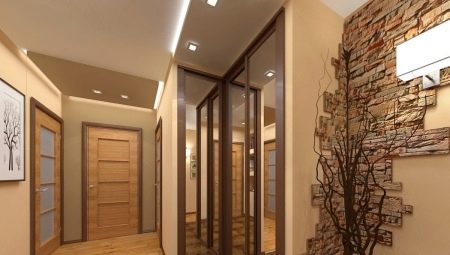
Today it is customary to pay special attention to the decoration of the home. And since it is the entrance hall that creates the first impression, you have to approach its design thoroughly. A special proportion of solidity can be given to the interior by finishing with decorative stone. The material in this article will tell you about the nuances of the material, its varieties, pros and cons.




Peculiarities
By decorative stone for cladding the walls of the hallway, it is customary to mean industrially produced materials of various types. They are united by their appearance: such a facing surface gives the impression of masonry. The name is not synonymous with a natural analogue: these are different products. This finish looks very status and effective.
They use an extraordinary interior decoration both in a city apartment and in a country house or cottage. In this case, the material can be a tool for accentuating one of the walls of the hallway. Often they are finished with "torn stone", through which a special style of the interior is created.
Thus, an old style is created, and different places of the room can be trimmed in this style (for example, an arched opening, a corner of a hallway, a niche).

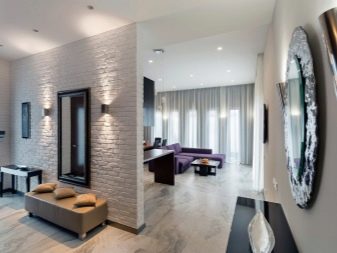


Usually, all walls of the hallway are not faced with such a stone, since with an abundance of stone surfaces, the effect of visual weighting of the space is immediately created. In addition, the stone loses its expressiveness with its excess. For an appropriate aesthetic perception of the interior of the hallway, it has to be combined with plain plain walls without a pattern.Due to a wide range of variations, the buyer has the opportunity to choose the size, which avoids incorrect design.
One of the distinctive properties of this material is the ability to imitate natural stone. The artificial analogue is lighter than the natural one, and also cheaper, which makes it attractive to buyers.
Today, this cladding is among the top ten types of wall covering. However, the degree of practicality of the stone directly depends on the type of raw material from which it is produced. That is why the characteristics of the finish can vary significantly.




Advantages and disadvantages
The decorative stone has a lot of advantages. These include the following:
- it does not create a significant weight load, which is inherent in natural material;
- characterized by environmental friendliness, and therefore safe for the health of households;
- not afraid of mold, mildew, does not rust and does not decompose during operation;
- differs in an acceptable cost in comparison with a natural analogue;
- it stands out for its significant service life, a variety of shapes and sizes;
- unpretentious to the type of base and gets along well with concrete, brick and wood;
- has a flat and smooth back, which greatly simplifies the cladding;
- looks beautiful due to its texture, may differ in color solutions;
- unobtrusive in styling, although it is better to carry it out to a specialist;
- not capricious when choosing a contrasting type of wall cladding, combined with concrete, plaster, wallpaper.
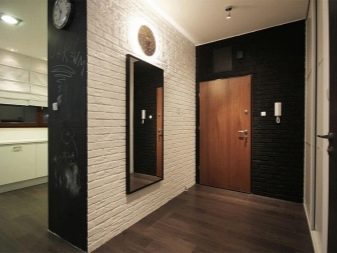



Composite material is characterized by a wide range of design possibilities... The stone is also good because certain decorative elements can be created from it. It could be a miniature turret or a castle design. It can also be used to accentuate wall lamps located in the corridor. However, along with the advantages of artificial stone for decorating the hallway, there are several disadvantages. For example:
- the stone loves light, which is why the facing surface has to be supplemented with its own lighting;
- when choosing a masonry design, a stone needs to take into account the visual techniques of a particular space to be trimmed;
- the material is not so easy to clean, and some of its varieties do not provide for it at all;
- some types of material are unstable to scratches, which is why, when facing, you have to select light colors on which scuffs will be the least noticeable;
- not all artificial stone is suitable for cladding the hallways of city apartments with a small area;
- after making the finishing stone, it is necessary to gain strength and lie down.




Species overview
Stone finishing can be classified according to several criteria (size, shape, color). Some types of material are harvested by the craftsmen on their own (say, gypsum stone). Artificial stone can be made from different raw materials, which determines its quality and strength characteristics, as well as the service life... It can be gypsum, concrete, clinker or agglomerate and porcelain stoneware. Each type has its own characteristics.
Gypsum is easier to work with than other analogs, weighs less, and has the richest choice of design, which is why it is easy to match it to the interior of the rooms of many styles. It is also convenient because it can be glued to a plasterboard base.
It costs less than concrete, is not afraid of temperature changes, and is fire resistant. However, it is fragile, and besides, it is afraid of moisture, and therefore it is customary to cover such a facing with a special compound.



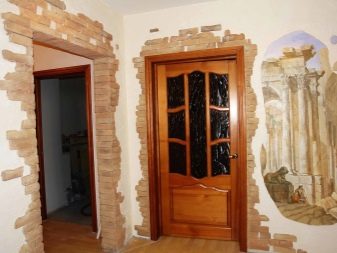
Concrete stone is made from sand, cement, and coloring pigments. Such a stone is quite strong and durable, it is completely inert to moisture and mechanical damage. Today, its color can be very diverse, like that of plaster stone. However, if gypsum is easy to process, then concrete is difficult to cut. The downside to the finish is the heavier weight.


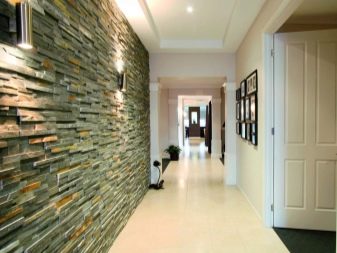
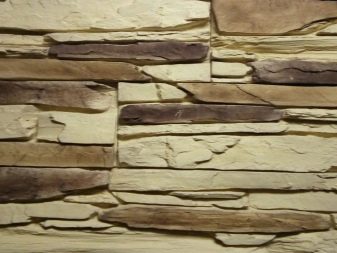
Clinker tiles, which is made of clay, looks like bricks, but its width is much smaller. As a result, the clinker is optimally lightweight. It is made from a mixture of marble and granite chips with limestone, sand and dyes. Unlike another stone, its front part is quite factual, which means that two adjacent stones do not always coincide in thickness. The agglomerate looks super stylish.


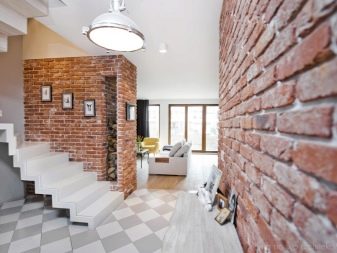

Porcelain stoneware made from clay, feldspar, minerals and dyes. Outwardly, such a stone is similar to glass tiles. Despite its strength, resistance to moisture and temperature drops, it does not withstand cleaning the facing surfaces with abrasives. It is susceptible to scratches caused by cleaning.
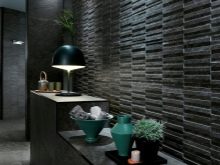
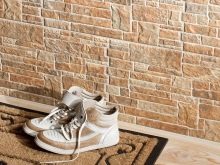

Known in industrial circles and the so-called flexible stone. In fact, it is a thin layer of sandstone with a characteristic pattern. This is an alternative stone wallpaper 1 mm thick, which is created at the mining site by transferring to a cloth with acrylic glue, implying drying. This wallpaper can be used on a variety of surfaces, including arched forms and columns.



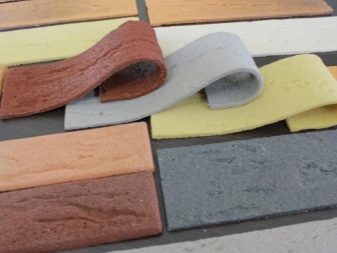
The shape of the material may vary. Sometimes it tends to be square, more often rectangular. In this case, rectangles can be both traditional and very narrow. Laying can be complicated by the fact that it will require the selection of each element.
If for a brick form this is not so significant, then for clinker, which is laid close to fragment by fragment, the work will resemble the collection of puzzles.
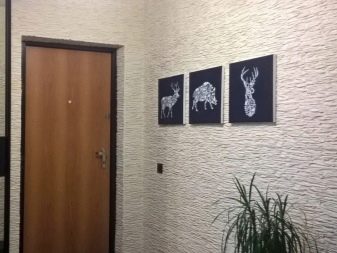



Design
Design solutions for the front surface of an artificial stone can be very diverse. In search of fresh ideas, along with already traditional options, manufacturers produce unusual types of cladding, focusing on its distinctive aesthetic qualities. For example, the brick form has become a kind of classic today. So that the interior of the hallway has a special atmosphere, the cladding is given an aged look (say, weathered, chipped, crumbled).
However, traces of bygone eras can be adorned with materials of other forms. The texture can be deliberately chipped, stylized, for example, like raw marble, granite and even quartz. No less catchy in the interior of the hallway can look a variant of the design of a rubble type, in which the wall will seem to be finished with stony debris of rocks.




Someone will like it sawn stone, which differs from other analogues in texture without grinding the front side. Outwardly, it may resemble sandstone or limestone. Such a stone is distinguished by the clarity of the edges. There are also marble and granite claddings in the assortments of manufacturers.
Among other varieties, it can be noted option for a mosaic. With it, you can lay out both abstract motifs and certain stone compositions on the walls of the hallway. For example, it can be a silhouette of an animal, a simple landscape, a pixel composition, or even a portrait of a person.
If you want something special at all, you can purchase a fancy type of stone cladding. Basically, it is a rocky finish that mimics the kind of stone that does not exist in nature.


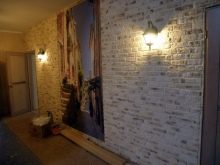
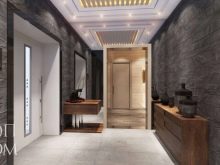

As for the type of cladding, a lot depends not only on the type of stone and the preferences of the owners of the house. The visual effect is also important, which will depend on the type of layout and the shape of the hallway itself. Interior decoration can be different:
- you can choose porcelain stoneware with the texture of expensive marble, mosaic and even parquet as the basis for the design;
- someone will like the pebble texture more - a practical and stylish solution that will decorate the interior of the corridor;
- the floor at the entrance can be laid out with crushed stone, placing it on a concrete base;
- you can use a combination of stone on the walls and floor in the interior, which will increase the aesthetic perception of the interior of the corridor;
- embossed installation can be combined with painting, wood or bamboo wall panels.



As for the combination with wallpaper, here the owners of the home have great opportunities. In addition to traditional roll options, the stone looks great in contrast to the so-called liquid wallpaper, which is spread on the walls with a spatula, like plaster. Among the traditional panels, non-woven and glass fiber wallpaper can be distinguished. The latter not only look good with the stone and help to increase its expressiveness, but are also practical, because they can be repainted several times at will.
Stone walls are combined with photowall-paper, if you choose the right subject matter of the image, as well as the material of the panels. So that color solutions are harmonious, it is necessary to take into account the game colors.
For example, when the stone in the hallway is dark, it is preferable to smooth out its effect not only with backlighting, but also with light wallpaper. As a rule, in this case, they should be at least a couple of tones lighter than the stone.
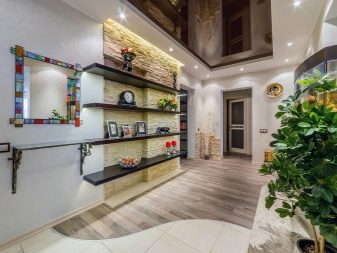



Finishing options
Of considerable importance in the selection of decorative facing stone is the stylistic solution of the interior of the entire apartment. The stone will look harmonious in the design if it becomes its accent, a highlight, hinting at a craving for a certain interior style. On the one hand, it seems universal, but if you carefully study the resources of a particular style, then it will not be difficult to fit it into the one you need.
For example, if you want to create a special atmosphere in the interior of a style apartment high tech, it is necessary to choose a cladding with a smooth texture that gives off shine. For example, it can be a finish that imitates marble, slate, granite texture.
If you need to create the mood of a certain era (for example, antiquity), you can turn to the texture under the light sandstone.




Color solutions of stone cladding will help a lot when choosing a particular design. Today, the stone can be neutral (white, gray, black), brownish, with a characteristic pattern (for example, marble stains), consisting of a combination of several tones of the color palette. For a rustic style (country), you can use earth tone cladding, reddish ocher. Provence, on the other hand, needs whitewashed wall tones. In view of this, here it is better to lay out an accent stone on the walls in a cool beige, pale pistachio, bleached turquoise tone. Concerning medieval flavor, then here it is necessary to rely on the grayish tones of the stone - from light to dark.
Imitation of aging and some shabbyness can decorate the interior of the hallway style loft or grunge. On the floor of the minimalist style corridor, there is enough porcelain stoneware with a simple texture without unnecessary decor. You can decorate doorways of vintage design directions with finishing "Torn stone".
However, when choosing one or another type of texture of stone cladding indoors, you need to pay attention to the fact that without proper lighting, the accent part of the interior may not look as intended.



In the dark, the decoration can be lost, become unprepossessing, which will have a bad effect on the aesthetics of the interior of the hallway and can spoil the overall impression of the home. Depending on the needs of the style, you can highlight the accent parts of the walls with lighting devices in cold or warm colors of the light flux. The light can be either soft golden or cool white. Its use will provide the necessary shadow play.


Different lighting devices can be used to illuminate the stone. For example, it can be floor lamps, wall sconces, ceiling spotlights, as well as spots, characterized by the ability to adjust the angle of the luminous flux. Someone prefers to highlight the stone on the walls with a flexible LED strip. In general, the design of the interior decoration should look harmonious, taking into account the choice of stylistic solution.



Wherein luminaires must accurately convey the desired atmosphere. For example, a modern entrance hallway with stone wall decoration can be illuminated with modern design lighting fixtures.
For modern, hi-tech, it can be spots and tape, for a loft - spots, or even stylization of lamps for street lamps. Also, against the background of a stone finish, it will be appropriate to look at the design of the lamp in the form of a metal pipe.
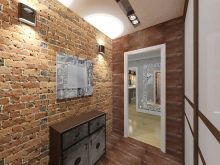


Sometimes, to create the right atmosphere in the interior of the hallway, they use unusual lighting devices. For example, it can be models with the design of kerosene lamps, or even torches. As for decorating stone walls, in addition to lamps, you can decorate the finished layout with both photographs in laconic frames and reproductions of paintings by famous artists. Someone appropriately fits into the design of hooks for clothes, others decorate the walls with thematic panels that match the style of the hallway interior.
Looks beautifully on stone walls under a brick or clinker clock. However, they can even be a frame with a dial. If the stone was used to accentuate niches, then they are usually complemented by LED lighting. Less often, shelves are mounted on walls with stone trim. Despite the fact that installation on such a surface is not so simple, the shelves look very impressive in such an interior.



The options for interior decoration of the corridor walls with artificial stone may be different. The decorative stone in the hallway can be laid out on the wall at the entrance, and also partially on two adjacent walls. It can occupy half of the wall, being located not only standardly, but also diagonally. Depending on the area of the corridor, it can be a decoration of only one section or have support on any of the walls.




Beautiful examples
We suggest referring to examples of photo galleries, which clearly show the possibilities of decorative stone to improve the aesthetics of the hallway interior.
- Accentuating the wall at the front door using wall lighting.
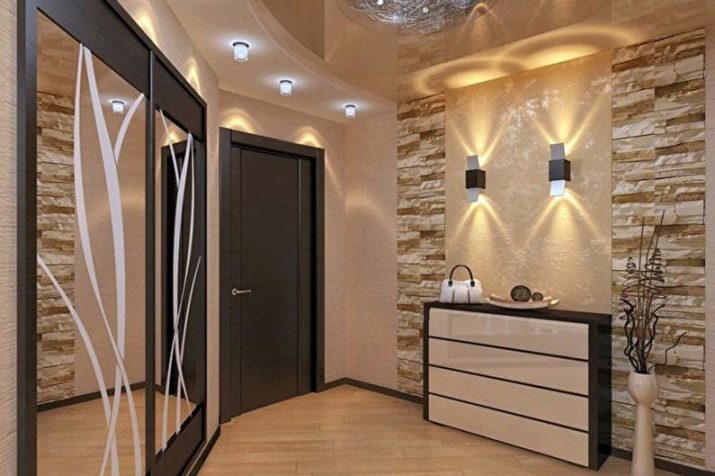
- An example of a cladding on one wall with stone support in the design of niches.

- Volumetric pixel design to accentuate the hallway wall.
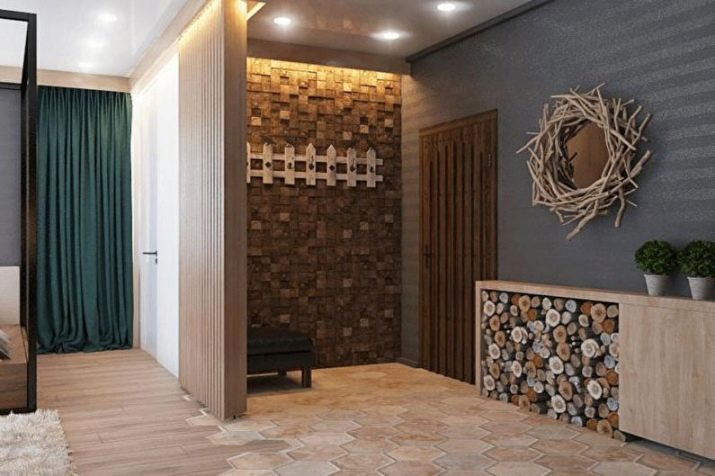
- The use of clinker in the interior of the hallway of a modern style.

- Highlighting the front door and walls near it with a stone in a torn layout technique.

- Stone with a smooth and shiny texture in the design of a modern hallway.

- Light stone against the background of contrasting cladding of adjacent walls.

- Accentuating the area with a stone with a large mirror and a light pedestal.

- An example of a creative neighborhood of decoration in the form of a brick wall and a shelf of an unusual design.
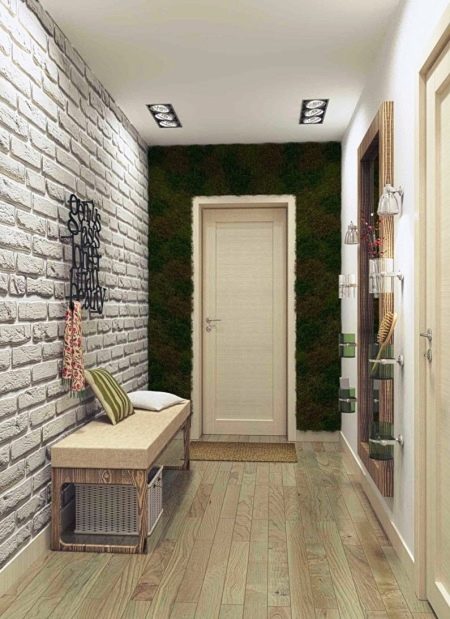
- Volumetric textured finish with vertical placement of wall lamps.

A master class on facing a hallway with decorative stone, see below.








